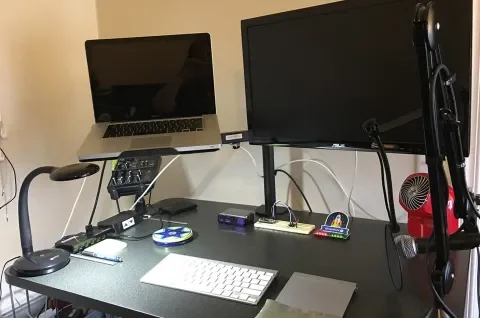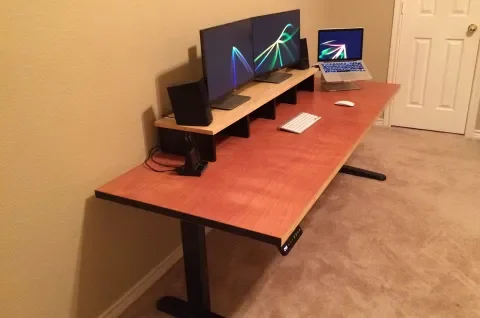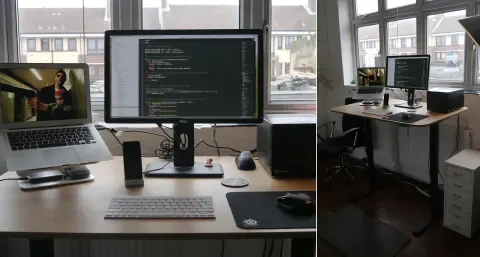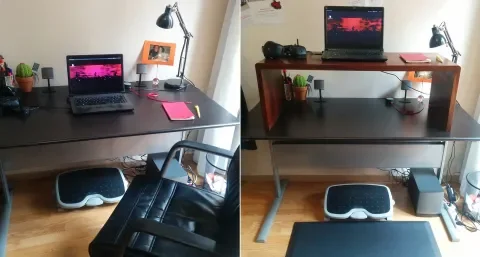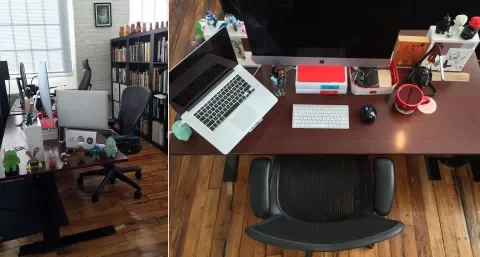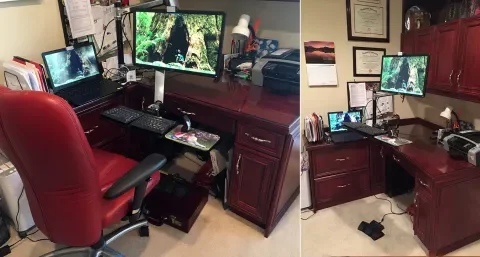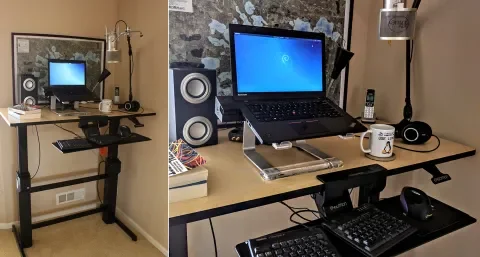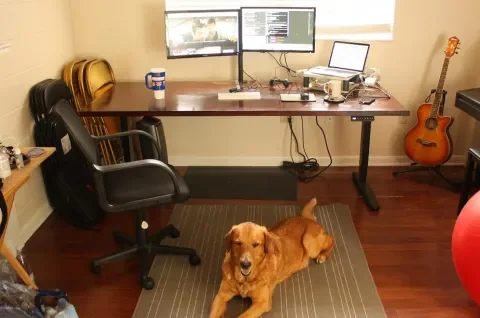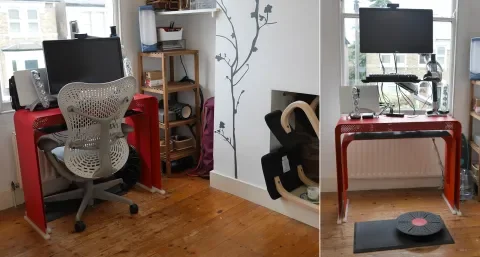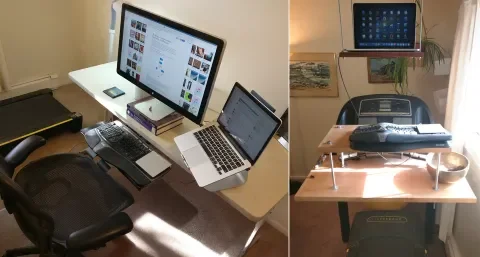When I ask lead ergonomist and physical therapist Matthew Marino of Portland, Ore., “What is the best position to work from?” he replies, “the next position.” The human body was built to move, not to be still. Standing desks will not save us from “sitting is the new smoking,” or, as the guru of Barefoot Running, Christopher McDougall, wrote in a recent issue of Outside Magazine, Sitting Wrecks Your Body. More Standing Isn't the Solution. In fact, standing all day at a desk may be even harder on the heart than sitting, not to mention a recipe for varicose veins.
As a distributed company of developers and designers tied to our computers both for communication and for work, it’s important to find ways to incorporate movement into our day and to change positions regularly. Here are nine individual workstations that allow the Lullabots to remain “computer athletes” and one from a pro-ergonomist to show you how the real ergo nerds do it. Prepare to geek out on state-of-the-art sit-stand desks, treadmill desks, anti-fatigue mats, foam rollers, and theracanes, along with some nifty DIY creations to inspire your imagination.
What kind of workspace do you have?
Amber Matz, Production Manager and Trainer, Drupalize.Me: I have an adjustable-height standing desk (the UPLIFT 975 Height-Adjustable Standing Pedestal Desk from The Human Solution) with a thick “anti-fatigue” mat. Sometimes I use this adjustable “sit-stand” stool to relieve my low back. All my equipment is clamped onto the desk so that I can raise it to eye-level, including this combined laptop/monitor arm mount stand. Since I do a lot of screen recording, I also have a microphone and tiny soundboard clamped on as well.
Ben Chavet, Senior Systems Administrator: I currently have an adjustable-height desk. Before this, I had an L-shaped desk with one side at sitting height, and the other at standing height, which worked great when I only had a laptop to move back and forth. I made most of my workspace myself, except for the adjustable-height frame. My monitors were about 4-6 inches too short, which strained my neck, so I built a nice monitor stand to bring them up to a comfortable height.
Joe Fender, Senior Drupal Developer: I have an Ikea Standing Desk. When standing, I use an Imprint Cumulus9 Comfort Mat which was the most highly rated.
Juampy Novillo Requena, Senior Drupal Developer: In the mornings I go to a co-working space where I sit. I walk back and forth. At home, I have a standard desk. A couple of times per week I add a small desk on top to build a standing workspace. I don't spend more than four hours standing.
Marissa Epstein, Senior UX Designer: I have a XDesk Terra, an adjustable, motorized standing desk. When standing, I use a CumulusPro anti-fatigue mat. When the desk is lowered, I sit in an Aeron chair. It’s a little awkward sometimes, but I work on a combination of Macbook (on a Rain mStand) and iMac (on some cookbooks). I also recently converted a Confidence Power Plus treadmill so that it fits under my desk.
Matt Marino, Owner of Optimum Performance Services, LLC and Lead Ergonomist and Physical Therapist with Briotix in Portland: I have home-office built-ins at my house which I didn’t want to rip out, so I installed an Ergotron LX sit-stand system with a grommet mount. The installation required some drilling and a custom glass top surface but otherwise was an easy install. I have a large Dell monitor on the arm. Currently I have a Kinesis Freestyle2 Blue keyboard, and DXT mouse on the tray, and Savant Elite2 triple pedal on the floor. There are many good keyboard and mouse options. For traveling, I like the SwiftpointGT mouse over my laptop trackpad. I have a Via Voss chair, a Via Swopper stool and a Focal Mogo to switch up my seating/perching options. My home office is large enough that I can move around, exercise, and stretch. I have plenty of natural light with no glare issues. I have a door to keep kids out when I need to put my head down and work. I like being able to walk around my house or my neighborhood when I take breaks and use the exercise equipment in the garage for a quick workout.
Matthew Tift, Senior Drupal Developer: My desk is adjustable height, but I mostly stand. I have an adjustable height keyboard tray and my laptop sits on a stand so that the top of the screen is eye level. For the past decade or more, I’ve been using a vertical mouse and an adjustable split keyboard which significantly reduces pain in my hand and arms. Because I do a lot of audio conferences and recording, I have a Yeti microphone with a pop filter on a boom arm attached to my desk that allows me to stand or sit while recording.
Mike Herchel, Front-end Developer: I have an electronic, adjustable-height standing desk. I can set the proper height for sitting and standing and then switch by pressing a button, and it will rise and fall. It's a Jarvis adjustable standing desk frame. I use a huge 80 x 36 inch (2M x 1M) door for my desktop. I have room to spread out.
Sally Young, Senior Developer: I started with a sitting OneLess desk. Then I added some Ergomart arms so I could move to any height and stand up, as well as a rubber mat. Then I added a kneeling chair. It doesn't take up much space, and the lack of excess surfaces prevents me from storing non-essential items on my desk—I get distracted by messy surfaces.
Seth Brown, Chief Operating Officer: I go back and forth between sitting on a Fitball, sitting on a Herman Miller Aeron Size C Chair, and walking at a treadmill desk. I secured the laptop cradle for the treadmill desk to the ceiling using All Thread so the height is adjustable and it prevents treadmill vibration from affecting my view.
What do you love about your workspace?
Amber: I like being able to record screencasts standing up. It might sound funny, but it’s easier to breathe and sustain my energy.
Joe: I have a lot of natural light. I can switch between standing (usually in the AM) and sitting (in the PM).
Marissa: It's a bigger desk than my last one, and I can keep it organized—there's a power strip attached to the underside of the desk, so all my cables are tidy. I feel like I have a comfortable amount of space. I love that I was able to make it my own: I covered the desk in art and favorites from my toy collection.
Mike: I have a unique situation where I don't work out of my house. I have some friends that rent me their home during the day while they go to their office jobs, providing me with a workspace that's completely separate from my family life. It also gets me into a routine where I have to get up, shower, and put on pants—this can be tough to do when you're working from home.
Seth: I love having the privacy to be on calls (my voice carries), the comfort of choosing my own tools and way of working, and the ability to walk on the treadmill during calls even if it's too cold or windy to do so outside.
How does your workspace help you manage or avoid pain, fatigue, or discomfort?
Amber: It helps to have a choice of standing or sitting. I can’t stand for long periods of time without my back hurting, but I could say the same for sitting. So being able to adjust the height makes it easy to switch between standing and sitting (or half-standing, with the stool that I have).
Ben: I have problems with my knees, hips, and tailbone. So, I stand to give my tailbone relief, and I sit to give my knees and hips relief. It's a balancing act, and I notice the days that I don't get the right balance. Besides the physical benefits of alternating, I find that I focus better on certain tasks when I'm sitting vs. standing, and vice-versa.
Joe: The standing mat was a huge benefit for me. Without it, I was getting a lot of leg pain. Now I get none!
Juampy: I have a footrest, which is useful when I am sitting. I also have a resting mat for my feet when I am standing.
Marissa: I stand roughly every 20 minutes each hour, which prevents me from getting stiff. I also have a yoga mat nearby, and little stretch breaks go a long way to relieving tightness.
Matt: Sit-stand transitions. Neutral postures. Ability to move around, exercise, stretch, and take breaks.
Matthew: There are lots of windows next to my desk, so I have a nice view of my yard. I switch back and forth between standing and sitting on a yoga ball throughout the day, with my screen always at eye level and my arms always at a 90-degree angle.
Sally: I'm currently undergoing physical therapy, which was my impetus to convert my desk to sit-stand. Keeping my body moving even slightly during the day has helped to significantly reduce the amount of pain I have down my neck and shoulder over time. When I sit down, I use a Herman Miller Mirra chair, and for kneeling I use a Varier Balans. I also use a mechanical keyboard and vertical mouse, which significantly reduces the fatigue on my hands.
What problems remain? Amber: The standing desk is not a cure-all. With my back issues, if I don’t stretch regularly, it’s just not comfortable to stand for a long period.
Joe: There is no memory setting on my standing desk, so I end up making a rough guess where it should go when I switch stances.
Matthew: I have not found a good place to put the yoga ball I use as a chair
Sally: The docking station for my laptop isn't ideal as occasionally I'll knock the power cable out, which deactivates clamshell mode, but I probably won't change it until the next new laptop I get. Also, my cat likes to knock things off my desk.
Is there anything you would like to improve about your workspace?
Amber: I am still not completely satisfied with the chair or stool I have for my adjustable height desk. I am not sure what would be the best solution, and with chairs being as expensive as they are, it’s impractical to iterate and experiment. I have a comfy chair by the window that I resort to in those early mornings when I'm not quite awake yet, which I love.
Ben: I need a new chair. I split my time relatively evenly between sitting and standing. Even with a better chair, I think that would continue. But, I notice that my posture isn't great when I'm sitting and that I develop pain-points, which causes me to shift a lot. I could also probably use an anti-fatigue mat to stand on. My office is carpeted, and I tend to wear shoes when I stand so that it could be worse, but it could be better.
Joe: I want to have as few wires as possible. Mainly because it makes removing my laptop from the stand and moving around the house (or going out) easier. At the moment I have four things to unplug when I do this, which is tedious. The new MacBook seems to be an improvement (just a single USB Type-C connector).
Marissa: I’m thinking about buying a standing aid, like the Focal Upright Mogo. Supposedly the angle it positions you in is fabulous for posture.
Matt: I’d like an electric desk like the Jarvis with a monitor arm. Because my sit-stand system relies on arms, it blocks a ton of work surface area rendering it useless to me.
Matthew: Sometimes I listen to music through speakers, but during calls, I need to use headphones to avoid feedback, so I’m currently searching for an audio switch box that would allow me to alternate between speakers and headphones with a click of a button.
What other things do you do to support your health and avoid injury? Amber: I tend to alternate between standing and sitting and try to take regular walking breaks.
Ben: I take regular walks. I have an hour blocked off of my calendar every day to protect the time and get a reminder to get outside and walk. The movement helps my joints, and the time away from my desk helps clear my head.
Joe: I usually go to the gym four weekdays and do strength training. It's a good way to start the day for me and gets me out of the house. Climbing on the weekends gives me the strength in my forearms to avoid injuries from typing all day.
Juampy: I play squash, do yoga once a week and walk every day. If I don't move in a whole day, my body gets stiff.
Marissa: Besides standing, I see a chiropractor once a month and inconsistently do yoga. I try to walk on the treadmill during my few calls without video. Otherwise, not much.
Matt: Breaks, sit-stand transitions, walking, stretching, exercise, and Jedi training.
Matthew: Everyday around lunch time I take an hour break outside to completely clear my head and give my hands a rest—running, road biking when the weather is nice, fat biking in the winter, cyclocross to mix things up. When I decided to make this daily break a high priority, I started noticing many other benefits such as improved concentration while working and greater patience overall.
Sally: I do pilates, cycling and weightlifting regularly, as well as dancing. I keep some exercise equipment next to my desk. I'll often use a Deuserband to stretch while standing at my desk, or a Thera Cane if I have any knots. If it's a particularly bad day, I'll take a break now and then to use a gridded foam roller.
Seth: I break up the middle of the day with a long, lunchtime workout. Don't sit for 8 hours straight! For me, having flex time allows me to plan a two-hour block for a mid-day exercise routine. If you have issues, seek out a physical therapist and build a workout tailored to address your specific issues. Everyone could use more core strength, but other adjustments are more subtle. You don't want to make overuse injuries worse by lifting weights, but there are often clever ways to strengthen your weaknesses without inflaming your RSI. You need the help of a physical therapist to figure this out.
Do you have a favorite tech or software that encourages you to work in a healthy way?
Ben: I have a Fitbit, and initially was obsessed with hitting my 10,000 steps every day. Lately, though, it's an afterthought, but I do like to look at the day-to-day trends.
Juampy: Fitbit! Especially when you add friends and groups.
Marissa: My desk comes with an app called Pulse, that lets you set standing goals and pops up reminders. It suggests when I should stand and sit, and adds up my time for the day. I've had my Fitbit on since the day Lullabot got it for me! Definitely, a nice way to keep yourself from losing track of the big picture.
Matthew: I have RSI Break (Time Out for Mac users or hack together your own version) set to make my screen go black for 20 seconds every 20 minutes. During that 20 seconds I do yoga, stretches, quick walk around house, etc. Other times during the day I try to focus on an object at least 200 feet away for that 20 seconds. At first I found this practice to be enormously annoying, but I have found peace with regular breaks, especially since my vision has improved markedly and I am now basically pain free. For me, free software that forces me to pause regularly helps me keep my life in balance.
Sally: I use Runkeeper to track all my activities, as well as give and receive encouragement from friends.
Seth: I use Pomodoro Timer, working for 24 minutes and then taking a 6-minute break to stretch or roll on a foam roller. I only take the break if I've been sitting the entire 24 minutes.
What advice would give someone who wanted to create a more ergonomic workspace?
Ben: Start cheap, and iterate. Start by stacking things on books. Use cheap Ikea furniture to experiment with standing. Upgrade when it feels right, and don't be afraid to make adjustments over time.
Joe: Having a standing desk has done wonders for how well I can think.
Juampy: Try a standing desk for a couple of hours to start with.
Matthew: I have known a lot of people who have developed hand pain from mouse overuse, so I highly recommend a vertical mouse which I find much more natural. If you mostly keep your hands on the keyboard while you are working, then I would recommend a split keyboard.
Mike: I finished the door for my desk with multiple layers of polyurethane, and it came out looking bad. It's functional, but not too pretty. Standing desks are awesome. I highly recommend the one I have. Next time, I'll purchase the desktop from Ikea instead of make my own.
Seth: I believe in investing in a really good chair. You're going to spend as much time in your chair as you do on your mattress, maybe more, and you need comfort and lumbar support. I'm a big fan of spending the extra money for quality here. In addition... Walking on a treadmill is great because I stay warm, even when it's really cold in the office, which means I don't hurt my wrists. Strive for a desk/chair/keyboard alignment that allows your knees and elbows to form right angles. Keep the top of your monitor at eye level. You can't do these things with just a laptop. You need an extra monitor. Prop the monitor to just the right height using old textbooks or stacks of printer paper. Switch from sitting to standing or sitting to treadmill as much as possible. Walk on non-video calls. Use a split keyboard over a standard keyboard and a trackpad over a mouse. Set your trackpad so you can touch to click rather than having to push it down. Never cradle the phone between neck and shoulder especially not while typing. NOTHING will get you injured faster. * If you're exceptionally tall or short take exceptional precautions. The world isn't built for you by default.

